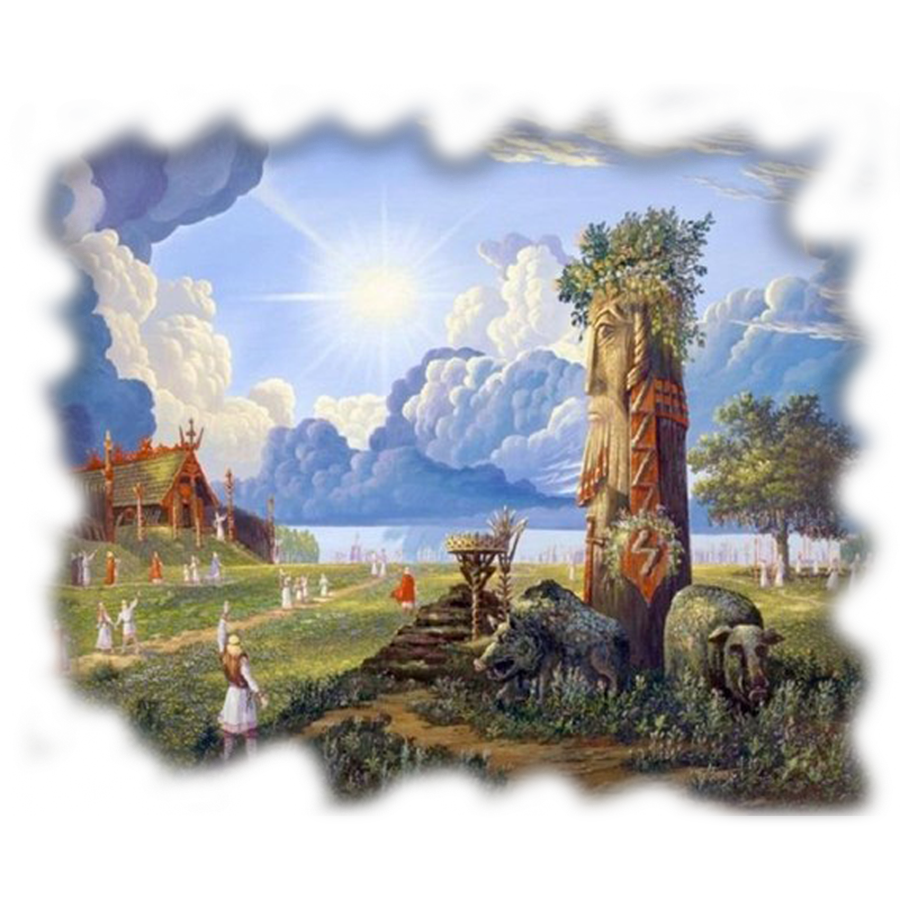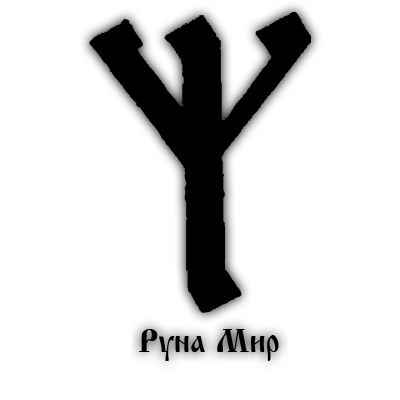Runes of the Slavs and their meaning. Slavic runes and runic alphabet. Work with runic frequency.
Anyone - Scandinavians, Indians, Germans, Egyptians and many other peoples, but not among the Slavs, but not among the Russians. Very often, the ancient Slavic runes and their significance are belittled by traditional historians - the value for the history of world civilizations has not been proven, they believe.
However, thanks to latest research Professor V. A. Chudinov, it is proved that the first and most ancient were precisely the ancient Slavic runes. The oldest Russian runes were put on stones 24-30 thousand years ago. All other runes and hieroglyphs are based on the Old Slavic or directly copy them.
This symbolizes the unity between the giver and the person to whom the gift has been given, creating a state of balance and harmony. Gebo is personified by the Northern Goddess Gefn, the "Charitable Donor". This gives us the opportunity to connect with other people, helping in the future common cause or business partnership. When illiterate people "signed" some document that linked them to some destination or contract, they used the Gebo rune to make their mark, that is, a gift from one person to another.
In runic work, we must mark the two features of Gebo only when we understand the meaning of the gift. The Wunjo form is a type of wind tasting such as those used in Vikings, pagan temples and churches in Scandinavia. No Scandinavian temple survives, but the churches were rebuilt using the same foundations. Wunjo means joy, an elusive state of harmony in a chaotic world. Joy can be found when one is in balance with things like tasting the wind that moves in harmony with the air currents that prevail. "Joy is for those who know little of sorrow," says the Anglo-Saxon poem. "He who is not troubled by sadness will have brilliant fruits, blessings, and sufficient constructions."

About the settlement of the Slavs around the world and that they came from the north from ancient Daaria (Hyperborea) - the mainland, which was located in the area of \u200b\u200bthe modern north pole (according to V. A. Chudinov, this was Greenland). Moving from north to south, all over the world, the Slavs carried with them the runic culture and writing. Mavro Orbini, forgotten by official historians, wrote about this back in the Middle Ages in the work “Slavic Kingdom”.
Forces of beginning and destruction
Wunjo is the central point between the two opposites, where alienation and anxiety disappear, as they are caused by lack or excess. This is the rune of brotherhood, common goals and common well-being, which helps us realize our true will, which we can use to fully meet our needs. It does this by manifesting harmonious ways of doing things, transforming our lives for the better.
When this rune appears in divination, Wunjo may mean good news from afar. The second Aett begins with the ninth Rune of Hagalaz. Hagalaz freezes and compresses. Literally, its name means "hail", which turns into water for a short time from liquid to solid. During this time, hail falls violently from the sky, thus destroying plantations or properties. But once the damage is done, it melts. Transformation is the dominant principle here, like the sudden transformation carried by a snowstorm.
The brightest fact runic letters are Etruscan inscriptions that can be read only if you use Russian syllabic runes. Even the ancient Romans said: "Etruscan is not readable."
Old Russian runes and their significance in the history of the development of writing
Runes were known and used for writing, with rare exceptions, by all the Slavs and the peoples around them. Runic writing (runitsa) is syllabic, not very convenient for everyday use. In addition to the syllabary, the Slavic Russians used the alphabet. After the displacement of Vedism by Christianity and the destruction of the stratum of the Magi, syllabic runes were used for some time by artisans and merchants in combination with alphabetic writing.
Green fields and black roads quickly turn into a white sea. Equally, the transformer is a thaw as the colors of the earth are restored. On a personal level, Hagalaz is the rune of the unconscious and the process of thinking. On the impersonal level, Hagalaz is at the roots of existence. Hagalaz gives us access to energies from the past that are still active in the present. He offers us the power of evolution in terms of present existence. The tenth rune is called Naudhiz or Ne. Naudhiz is two wooden branches used for fire, a powerful fire ritual that was used only during periods of disaster, such as a famine or some kind of plague outbreak in cattle.
Cyril and Methodius added purely Greek letters to designate Greek words and sounds, while removing those letters and sounds that Greek ears and language did not perceive. There are only 24 letters in the Greek alphabet and they are completely insufficient to convey all Russian sounds. Therefore, the Russian runic script, in which some researchers count up to 144 only the main runes, can in no way be derived from the Greek alphabet.
Naudhiz literally means "need", which represents both lack and absence of things, as well as the principle of necessity. All needs are limited, and Naudhiz limits our options. This is placed in an Anglo-Saxon runic poem which calls Nid "a tight bandage around the chest". But with the rune of Naudhiz there is also a power to be made unnecessary: "it can become a symbol of help", we are told, "if they are present early enough". As before, Hagalaz, Naudhiz is the rune of change.
When we use naudhiz, we must be careful, keeping in mind the ancient principle of "know thyself". By using it, we must not go against our destiny of the Wyrd - but we must use it constructively. This will help us overcome difficulties. Usually, however, the rune binds us and prevents us.
It was on the basis of runic writing that almost all alphabets in the world arose - from Latin to Chinese and Japanese hieroglyphs.
The sacred meaning of ancient Russian runes
It is believed that the runes are a gift from the god Veles and were created at the time of the creation of the universe. These are not just letters, these are images that convey information.
Sacral figurative meaning was available only to the Magi and was passed down by them from generation to generation. To understand the true meaning of the runes, it is not enough to know the meaning of a single rune - a lot in the interpretation depends on the order in which they are located.
The eleventh rune is called Isa. Rune Isa symbolizes static existence, the present. The ice is beautiful, something to see, but it doesn't do anything, and it's useless for the ancients. It is symbolic that Isa is a rune that paralyzes all activity. Ice forms because the lack of energy turns the liquid into a solid. The static resistance of ice replaces the fluidity of water. When ice is static, it sometimes moves in bulk. When this happens, like in an avalanche, it flows with irresistible force. Thus, Isa is an inexorable process against which we can do nothing.
It was with the help of runes that the ancient Russians kept in touch with the gods. Old Russian runes and their importance in everyday life can hardly be overestimated. With their help, the magi created protective amulets and amulets, conspiracies, fortune-telling and other magical rituals. For it was required to cast the necessary spell. Most often, 18 magic runes were used for sacred purposes:
Also, when it is in the form of an iceberg, the depth of the floating ice is misleading, as we can only see a ninth of the true mass above the surface. Therefore, the effects of Isa, which may seem insignificant, have unexpected consequences and dimensions.
Jera or Hara is the twelfth rune. It means "Year" or "Season", Jera refers to the cycles of existence. This is the rune of achievement. right time because a bountiful harvest can only happen if the right things are done at the right time. Gera cannot act against the natural order of things, but when used correctly, the result will be beneficial, as, as the Anglo-Saxon rune poem says, "bright abundance for the rich and the poor." Jeroo can be written in two different ways.
- The rune "There is" is the feminine principle on the entire planet.
- Rune "Ud" - male energy and strength.
- Rune "Dazhdbog" - symbolizes the fertilization of the Earth, the harvest.
- Rune "Chernobog" - reveals the hidden, secret powers of man.
- Rune "Rainbow" - a bridge between the worlds of Reveal and Navi, can open hidden abilities.
- Rune "Steal" - the need for spiritual development.
- Rune "Rock" - the power of the divine, natural order.
- Rune "Need - obedience to personal law-order, the use of knowledge for one's own benefit.
- Rune "Source" - the accumulation of internal power and strength.
- Rune "Strength" - a change in fate, the unity of opposites. Rule becomes one when Yav and Nav unite.
- Rune "Support" - the unification of consciousness with disparate parts of one's own "I" and the Universe, protects internal forces and emotions.
- Rune "Perun" - infinite power, control, absolute male power.
- Rune "Treba" - a sacrifice to the gods, designed to cleanse from everything superfluous - wealth, knowledge, talent, career.
- Rune "Bereginya" - protects the Slavs, women in labor and young mothers from representatives of another world.
- Rune "Wind" - divine enjoyment of the battle, death - the stage of the battle.
- Rune "Belbog" - craving for the achievement of the highest goal.
- Rune "Lelya" - the birth of a new one, the power and strength of the tree of the Family.
- Rune "Alatyr" - absolute peace, making the only right decisions.
To use the power of runes with benefit, you need to clearly understand their purpose. Knowledge of symbolism and mythology is required Slavic peoples. Without such knowledge, attempts to create a talisman or amulet can only bring harm or, in best case, give no result. We must not forget that the Slavic Russians did not have good and evil gods - all the gods were versatile and, depending on the circumstances, could be beneficial or harmful.
One is a vertical strike carrying a diamond. This form is the stable form once activated. It symbolizes the cosmic axis, surrounded by the four seasons of the year in right order. Here Hera is the pictogram of the object - a prefabricated garland that is supported by a mast. Another form consists of two angular features, such as two Kenaz runes, that interpenetrate each other without touching. This is the dynamic form of Jera, representing changes to the implementation.
This is one of the most powerful runes, which is a blue tree. Ancient rune wizards carved forked rods from the life and death of the yew. Because it combines longevity with toxicity, the yew has the power of death and restoration. Since it is the longest tree among all others in Europe and remains green throughout the year, the yew tree is the tree of life. Some ancient yews that have partially died are resurrected by their smaller trees that are born inside them.
When fortune telling, interpreting runes is possible only in combination. One by one, they cannot say anything even to an experienced user.
Currently, the ancient Slavic runes and their meaning are easy to study via the Internet - they are described on many sites. However, when choosing information for study, it is necessary to have basic knowledge about the life of the ancient Slavs, because there is a lot of conflicting information on the network that requires a critical attitude from the user.
These, in particular, are true symbols of the continuity of life. Others, the so-called "blood yews", never healed their wounds. Red resin passes through the tree of these wounds, but the tree is not affected. Bloody yews are considered sacred, healing trees. But the yew has a different side because its chest, root, leaves, fruits and resins are extremely poisonous. For this Rune Eihvaz is also called the "Rune of Death", a power fortified by its position as the number of the Rune for the ancient Erilaz, Eihvaz's gun is a magical protector and facilitator.
Slavic runes– more than just symbols. The culture of every nation is not only in fairy tales, legends and traditions. 
Krada, sacrificial fire. Rune of Truth
Its meaning is varied and depends on Erilaz's ability to understand his interpretations from his attributes and the game he is about to play. Another possibility is a pawn or a play. Both parts or data represent uncertainties in the game of life. As a game, Perdhru symbolizes the interaction of freedom of choice with limitations and circumstances. When we play, the board standards and the rules of the game are already dictated. But apart from these restrictions, the movements of our game are free. Playing the game depends on the ability and willingness of the players and their interaction.
A sign of a full-fledged culture is writing, with the help of which everything that happens with separate group people, people and civilization. And the Slavic-Aryan civilization is no exception - a lot of evidence has survived to this day that our ancestors were a highly educated race that knew, perhaps, even more than our generation.
Perdchrome is also the rune of remembrance and remembrance, problem solving and esoteric knowledge. It gives us access to both inner and secret knowledge. human world, as well as to internal action nature. This gives us the strength and ability to distinguish between valuable and useless things.
Modern pagans see Perdhra as the womb of the Great Goddess who brings life into existence. In this sense, it reveals things that were previously hidden, creating potential in physical reality. The fifteenth rune is Elkhaz, or Algiz. His form represents the strength and resistance of a powerful elk whose antlers intimidate enemies. Seeing the menacing ant, no one dares to attack, and Moose wins without a fight. Elhaz also symbolizes the plant "elongated" and "bicuda", whose pointed leaves repel animals from eating it.
Slavic runes, meaning, description and interpretation - this is part of the culture of the Slavs, and not only the ancients, but also the present. Slavic runic writing is a figurative writing of tribes belonging to the Slavic-Aryan race, used in pre-Christian times. Runes were known long before the appearance of the first variants of the Old Slavonic language based on Cyrillic and Glagolitic.
For the runemaster, Elhaz is the strongest symbol of protection for all, as he has the ability to ward off all evil. First of all, it is a rune of personal protection. Viewing this rune around your body gives you a powerful shield against all kinds of attacks, physical or mental. The supportive and defensive strength of Elhaz promises protection against all species, known or unknown, that conflict with us.
Symbolically, it represents the power of a person striving for divine power, with the help of the support of another world. Like Elhaz, Sovulo is a rune of great power that carries and directs the power of the sun, which it symbolizes. But it's not just energy: it also symbolizes the illumination that the sun provides. Figuratively speaking, he represents the forces necessary to achieve our goals. Its shape refers to the shape of a beam.
Some skeptics, especially those in Christian circles, argue that Slavic runes did not exist, but how to explain the strange symbols on the ancient temples located on the territory of our country. No one will argue that the sources, according to which it is possible to assert the presence of a runic ancient Slavic writing, is extremely small, so the question still remains open. But it's hard to find another logical explanation applied symbols on tools, weapons and household items of the ancient Slavs.
Home, family and property protection
Sovulo resists the forces of death and decay, ensuring the triumph of light over darkness. That is why it is the rune that illuminates our goals. "For people swimming in a fish bath, the sun is hope," says the Anglo-Saxon rune poem: "Even the horse of the seas brings it to the harbor." Keeping a clear vision and keeping our goals in Soulu's light vision helps us reach them. The first rune of the third Aetta is Teyvaz, and its sound is T. Since Ees Teyvaz is the Runic God, which is the rune of the ancient sky god northern Europe, Tivaz.
Protect Slavic runes - it is more than just symbols with which information could be stored. It is part of the culture, the knowledge preservation system. The symbolism of the Slavic runes consists of a special energy and information space in which the ancient Slavic peoples lived.
 It is worth immediately stipulating such a moment that the very concept of “Slavic runes” cannot be considered absolute, since the Slavs are only half of the Race - Rasen and Svyatorus. The second half of the Race - Ha'Aryans and Da'Aryans have a slightly different name - Aryans. But this point is the topic of a separate discussion and even a scientific treatise, which can serve as the basis for writing a doctoral dissertation. Therefore, Slavic runes are enough general definition, which is worth discussing in more detail.
It is worth immediately stipulating such a moment that the very concept of “Slavic runes” cannot be considered absolute, since the Slavs are only half of the Race - Rasen and Svyatorus. The second half of the Race - Ha'Aryans and Da'Aryans have a slightly different name - Aryans. But this point is the topic of a separate discussion and even a scientific treatise, which can serve as the basis for writing a doctoral dissertation. Therefore, Slavic runes are enough general definition, which is worth discussing in more detail.
It is known in ancient England as Tiv and in Scandinavia as Tyr, and gave its name on the third day of the week. The power of Teivaz is told in Scandinavian myths, when the mighty God sacrificed his right hand to allow the destructive Wolf Fenris, who threatened the balance of the world, to be arrested. So, the rune of Teyvaz is a positive rune of personal sacrifice in order to succeed in your goals. All success that comes from Teyvaz comes from sacrifice, which can mean personal stress, hard work, or financial risk.
In this case, Teivaz's success will only come if you really do it. Judicial misconduct does not occur when Teyvaz has power. Its shape represents the breast of the Mother Goddess, formerly called Nerthus, Berchta or Frau Percht. Birch is a white bark tree traditionally associated with clearing. As the first tree to reconsolidate the barren land when the ice receded at the end of the last ice age, it also symbolizes regeneration, spring and the return of warmth after the cold.
Runic writing was used for the first time by the Ha'Aryans, who compiled the first alphabet of runes - the Ha'Aryan Karuna. Simply put, karuna is a word inscription consisting of two runes, in which the rune “ka” means connection, and “rune” is the main element of such a peculiar writing. It is worth noting that each Great Family had its own script:
- The Da'Aryans have tragi,
- The Rasen have a gossip,
- The Svyatoruss have letters.
Today, there are no Slavic runes for writing symbols and letters, since all systems for tracing symbols are rather conditional. According to experts, Karuna was the most successful and perfect version of the letter, since it was simpler than other options in tracing and memorizing. An important feature of the Slavic runes is that their real number and full designation is unknown. For example, Pater Diy Svyatoslav knew about three million runic symbols.
Many people who are just starting to get interested Slavic culture, they mistakenly confuse Slavic runes with illiterate Vedic runes that have nothing to do with them, about which it is only known that they were primitive and practically did not carry any logical load. The ancient Slavs used their own runes for millions of years, and our contemporaries, who honor their roots, write or today.
Features of reading Slavic runes
It is important to understand that the standard 18 Slavic runes, which are most often found in many sources, are just a part of the runic symbols used by the ancient Slavs. Karuna had one feature that must be taken into account, the runes in it can have the most various meanings- it can be a single letter, and a syllable, and a word, and even whole image. It is worth saying that images in Slavic writing were a priority, and one rune could have up to three meanings, depending on the features of use (images that may be necessarily interconnected).
In order to write down the runes, slokas were used - 9 rows with 16 characters in each. Every 16 slokas formed larger letters - Santii. In order for Santii to be not just a series of symbols, but to carry an information and energy load, they were applied to precious metals(gold or silver) rolled into plates. On a metal plate, up to 4 slokas were applied on both sides, such a plate was also called Santia. 9 Santi, gathered into a single whole, were the Circle.
One of the features of writing slokas can be considered the fact that there are not 16, but 32 runes in a row. According to this rule, each first rune is a commentary on the second, taking into account the context of the entire text. Quite often, 64 runes are used, which indicate a double translation of the previously applied text. In order to correctly read the sloka of runes, it is necessary to read from the first line from left to right to the last line. After that, the procedure is repeated in reverse order, rising from the last rune to the first. According to the research of scientists and archaeological excavations, it is possible to read the text in two ways - by letters or by images. In the first, everything is simple and banal - each sound is encrypted with a symbol. In a figurative reading, it is initially determined key image, to which the rest of the runes are attached, and then the reading goes according to the standard algorithm. The result of such writing and reading is a message that is received by letters and images. It is worth saying that quite a lot of specific narrow-profile literature is devoted to the Slavic runes and their meaning, which is usually found in the closed funds of museums and central libraries not only our country, but the world.
In order to understand the basic principles of reading runes, consider an example - the name of a well-known Slavic god Perun. If it is written in runes as letters, then everything is simple - the name "Perun" will turn out. But if you read it in images, then the phrase will be much more complicated - "The path is our military joy." At the same time, one should not forget that there is an even more complex version of reading, but it is available in more historians and researchers, although if there is a desire, then an inquisitive descendant of the ancient Slavs will be able to figure it out.
How many runes are there and what do they mean?
The standard Karuna contains 144 runes, in addition to which one can single out the runes of movement, time, figurative (they are quite difficult to understand modern people). If we consider karunic records as a source of information, then they are not so difficult both when reading letters and images. For example, Veles is a two-runner, consisting of "ve" - the knower, and "forest" - the Universe. When writing with a capital letter instead of "e" in the "forest" rune, it is inscribed as "yat", so the image of the Universe is obtained, and not green spaces. And there are several thousand such examples of words that were used by our ancestors today, but you can read more about them in special historical and philological literature or in special university courses.
Quite often, one can also find the mention of the Kha'Aryan Karuna as a Scandinavian utkharka, consisting of 24 runes. Slavic runes and the Scandinavian utthark can only be used in an esoteric context, since they are just a part of a general karunic or symbolic system. If you look at the runes from the point of view of modernity, then they have somewhat lost their expediency of use. They can only be used to learn the traditions and customs of our ancestors, touching the lost and lost knowledge.
The meaning of the runes of the Slavic peoples
Slavic runes and their meaning is one of the main questions that interest modern Slavs. Their values can be obtained even without special knowledge, it is enough to know the gods and the names of the runes. The standard 18 runes, which are basic, are considered the most magical and are widely used in a variety of occult rituals. Runes are applied to any objects and surfaces, ranging from weapons to tattoos on the body. The decoding of Slavic runic amulets is closely related to specific Slavic deities, since each rune symbolizes one god. by the most simple interpretation counts:
- Wind - Veles;
- Bereginya - Mokosh;
- Ud - Yarilo;
- Need - King Navi Viy;
- World and Rod - Belobog;
- There is - Live.
An inquisitive descendant of the Slavs, who knows all the features of each god and their graphic interpretation, can make a charm on his own, partly fulfilling his purpose. The runes of the Slavs are part of the knowledge hidden from the average layman, they have hidden meaning, which allows you to use the traditions of paganism in order to improve interpersonal relationships, prosperity, and get a promotion. Amulets and amulets provide an opportunity to get the desired result, and to some extent remind you that you need to make decisions on your own in order to realize your plan. Popularity Slavic symbols over the past few years is explained by the fact that all more people dream to comprehend the secrets of the Aryan Slavs, to learn more about their traditions, beliefs and rituals. Therefore, today it is not a problem to buy a Slavic amulet, which will bring good luck, to establish relationships. Silver amulets are most in demand, since it was this metal that was always considered magical from the very beginning.
Slavic alphabets based on runes
In order to correctly understand and use the runes of the Slavs, it is important to know that there are not many basic runic alphabets, each of which has its own characteristics of use and application:
- Venedian (Vendian) runes are the alphabet used by the Slavs who lived in the south of the Baltic between the Elbe and the Vistula until the middle of the first millennium AD;
- Boyanov runes - they wrote the Boyanov Hymn in the fourth century (one of the most famous ancient Slavic epics). These runes are similar to the inscription of the symbols of the peoples of Greece, Asia Minor and the Black Sea coast;
- Veles runes - were used in cultural and social relations Eastern Slavs. With their help, chronicles were kept until the 9th century in Rus'. They wrote the "Book of Veles" - one of the main collections of rituals, legends and tales of the Slavs.
- Runica - according to some scientists, this alphabet has existed since the Paleolithic, on the basis of which the Cyrillic and Glagolitic alphabets were compiled. At the same time, there is a theory that such a “rune” is the basis for writing. ancient egypt and China.
It is worth remembering that Slavic runes are not just beautiful symbols, the application of which has become popular, it is part of our history. The issue of studying rune writing is a complex issue that requires not only basic knowledge of mythology, but also a fundamental study of cultural and social relations throughout the history of all civilizations that have contributed to the development and formation of mankind.
18 Slavic Runes used in modern times













![]()








